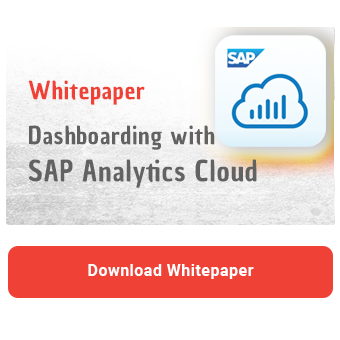In the context of digitalisation, companies are investing huge sums in SAP Analytics Cloud projects in order to increase efficiency and meet the ever-increasing business challenges. The success of these projects depends on the effective use of the applications developed. Ultimately, it is crucial that users accept the new tool and actively use it in their day-to-day work. Only then will the benefits predicted in the business case be realised. But how can you measure user acceptance? You will learn about this in this article.
The success of a project is largely dependent on user acceptance of the new applications. A lack of acceptance is a key risk factor for IT projects, as it means that the project objectives are not achieved. In addition to the loss of investment, opportunity costs also arise as the full potential of the solution is not utilised. Another consequence of a lack of acceptance is the creation of information silos and shadow IT.
In the case of reports and dashboards that have been developed without taking into account the real requirements of users, users create local reports in Excel themselves. These are known to be very error-prone and lead to problems that the project should actually solve. Planning applications are no different. Here, users revert to their old behaviour and only use the new planning tool as an input screen. The actual planning still takes place in Excel.
As a result, the workload increases for users who now have to keep the data synchronised between Excel and SAP Analytics Cloud. In addition, the quality decreases as this manual process is extremely error-prone. In addition, Excel exports also completely or at least partially undermine the authorisation concept. As SAP-wide analysis authorisations no longer apply in the Excel files and these are circulated without any control.
It must therefore be ensured that the developed tool actually meets the requirements of the users and can perform their tasks effectively. By measuring acceptance, any problems can be recognised in good time and appropriate countermeasures can be taken. SAP Analytics Cloud (SAC) provides a range of tools for this purpose, which are presented below.
Number of users
The System Overview is the first place to start collecting usage information. The Usage tab provides insights into user adoption.

The ‘Overview’ tab displays information such as the number of users of the respective application over a certain period of time. First, aggregated data for the entire tenant is displayed. Using the filter, the numbers for a specific module or individual stories can be viewed.

To gain deeper insights, the user numbers can be analysed over different time periods. In the ‘Adoption’ tab, you will find the ‘Open Story Actions’ diagram. Here you can view the accesses at monthly level (level 4 in the hierarchy). Alternatively, it is also possible to analyse at daily, weekly, quarterly or annual level. This allows you to analyse usage patterns over time. You will also find an overview of the top 10 and bottom 10 stories in the ‘General Content Usage’ tab.

Dashboarding with SAP Analytics Cloud -
Download the Whitepaper here!
Adoption Rate
In addition to the number of users, the adoption rate is another important key figure. This compares the number of authorised users with the number of active users. For example, if only four out of ten authorised users actually access a project resource, the adoption rate is 40%.
You can view this key figure on the right-hand side of the ‘Adoption’ tab. On the left-hand side, you can select a system folder or individual stories in the ‘Project overview’ table.

Story interactions
Another important key figure for evaluating user engagement is the number of interactions. This records the user actions within the story. These include navigation, filtering, data entry and execution of data actions. The total time of story interactions can be found in the system overview in the ‘Usage’ section. This can be refined using the filter.
Please note that this metric should be used with caution, as several actions are thrown together. In most cases, however, a high number of interactions correlates with higher user acceptance.

Session duration
In addition to the number of users and story interactions, the time that users spend interacting with the story also provides information about user acceptance. Under the path System → Performance → Statistics and Analysis → Frontend, you can display the median session duration. As a rule, a longer session duration indicates higher user engagement, while a shorter session duration could indicate a lack of interest.


Noticeably short session durations may indicate that the data was only exported to Excel in order to subsequently analyse the data there. This naturally leads to shadow reporting. However, it also shows that the story does not fulfil the users' analysis requirements or that they are not able to make friends with the new circumstances. In the next article, I will show you measures that you can take to improve user acceptance.
Measure user adoption in SAC - Our Summary
The built-in metrics of SAP Analytics Cloud offer the opportunity to gain more insights into user behaviour. The number of active users, number of sessions, adoption rate and session duration are among the most important key figures.
As there are no universal guidelines for these metrics, they should be considered in context of the respective project. Comparable projects within the company are a good benchmark. In addition, qualitative surveys should also be carried out at regular intervals in order to obtain the overall picture. If you need support with this, please do not hesitate to contact us.
SAP Analytics Cloud, Dashboarding

/Logo%202023%20final%20dunkelgrau.png?width=221&height=97&name=Logo%202023%20final%20dunkelgrau.png)
























